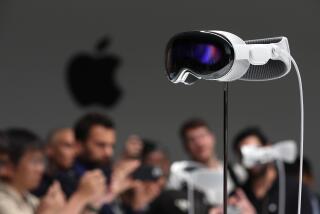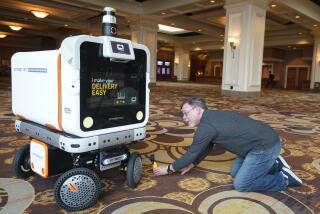Google, Microsoft, Apple and the race to a talking TV
- Share via
We’ve all been there -- lazily relaxing on the couch, when an engrossing TV or movie show wraps up and is inexplicably followed by something that you just don’t want to watch.
The channel needs to be changed but the remote is out of arm’s reach. Wouldn’t it be nice just to tell the TV to change the channel itself?
Soon, you may be able to do just that. Your TV will be able to follow your command, but for now you’ll still need the remote in hand.
Eventually, however, the remote won’t be mandatory and someday, your TV may even talk back.
The first steps of making all this a reality are already being taken by some of the biggest names in the tech industry -- Google, Sony, Samsung, LG, Microsoft and Apple too.
The Microsoft Xbox Kinect, a motion-sensing camera for the popular Xbox 360 video game console, has a built-in microphone and software to understand voice commands to search the Web using Microsoft’s Bing search engine, or to navigate between different video games and apps for streaming video such as Netflix and Hulu.
Google’s Google TV software, available on set-top boxes and TVs from the likes of Sony, Samsung, LG and Vizio, includes a feature to search the Web using voice commands spoken into a Google TV app found on handsets running Google’s Android operating system or Apple’s iPhone.
At the 2012 Consumer Electronics Show in Las Vegas this January, Samsung and LG showed off motion-sensing remote controls that feature built-in microphones for voice search that will arrive in stores later this year. But for now, Google’s voice input is limited to searching the Web and not changing the channel. But that, too, is likely to change soon.
On Sep. 29, 2011 -- six days before Apple introduced the iPhone 4S with Siri, the voice-commanded personal assistant app -- Google turned in a supplement to a May 19, 2011, filing with the U.S. Patent and Trademark Office that described technology that uses remote controls or handheld computers (smartphones and tablets) as an intermediary to tell a TV, by voice, to change the channel or even seek out specific programs. The filing was first reported by the website Patently Apple and obtained Tuesday by The Times.
In one example noted by Google in the filing, a user asks his TV, using a remote or smartphone, “When is Seinfeld on?” The listing for Seinfeld would then show up on a TV and on the handheld device.
Apple has been long rumored to be working on what has been unofficially dubbed the “iTV,” a television set of its own that could use the iPhone’s Siri technology to find TV shows or channels on demand.
For months, Microsoft has been rumored to be building its Kinect motion and voice technology into TVs, so that an Xbox 360 and external device aren’t needed. At the CES, Microsoft demoed interactive episodes of Sesame Street in which viewers spoke to characters and relied on gestures, such as throwing imaginary coconuts, to interact with the likes of Grover and Elmo.
The potential of what Microsoft, Google, Samsung and LG showed at the annual electronics showcase was clear.
A race is underway to allow us to talk to our TVs and for our TVs to talk back, and though Apple hasn’t said it has a horse in the competition, the words of the late Apple co-founder and long-time CEO, Steve Jobs, offer us a clue to what it may have in mind.
In a biography of Jobs written by Walter Issacson and published shortly after Jobs’ death in October, Jobs said that he had figured out an approach to TV that he thought could disrupt the $100-billion television industry.
“I’d like to create an integrated television set that is completely easy to use,” Jobs is quoted as saying in Issacson’s book, titled simply “Steve Jobs.”
“It would be seamlessly synced with all of your devices and ... will have the simplest user interface you could imagine. I finally cracked it,” Jobs said.
RELATED:
Apple iTV: Rounding up the rumors
CES 2012: The disruptive power of gesture and voice recognition
CES 2012: Sesame Street Kinect shows promise of TV voice, gesture control [Video]
Follow Nathan Olivarez-Giles on Google+, Facebook and Twitter






